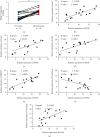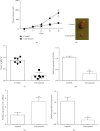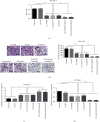Curcumol Targeting PAX8 Inhibits Ovarian Cancer Cell Migration and Invasion and Increases Chemotherapy Sensitivity of Niraparib
- PMID: 35548853
- PMCID: PMC9085303
- DOI: 10.1155/2022/3941630
Curcumol Targeting PAX8 Inhibits Ovarian Cancer Cell Migration and Invasion and Increases Chemotherapy Sensitivity of Niraparib
Abstract
Objective: To investigate the effects of Curcumol on invasion, migration and epithelial-mesenchymal transformation of IGROV-1 and OVCAR-3 cells in ovarian cancer and its potential mechanism. Meanwhile, the effect of Curcumol on the antitumor activity of Niraparib was analyzed.
Methods: Cell Counting Kit 8 (CCK-8) was used to detect the effects of Curcumol on the activity of IGROV-1 and OVCAR 3 cells. In vitro invasion assay (Transwell) was used to test the invasiveness of cells. Cell migration was detected by scratch assay. The inhibitory effect of Curcumol on PAX8 was detected by QRT-PCR. To evaluate the antitumor effect of Curcumol in subcutaneous tumor-bearing animal model.
Results: Knockdown of PAX8 could inhibit the proliferation, invasion and migration of ovarian cancer cells. After Curcumol treated IGROV-1 and OVCAR-3 cells, the cell proliferation ability was decreased, the number of invasive cells was significantly reduced, and the scratch closure rate was significantly reduced, in a dose-dependent manner. Mechanism studies showed that Curcumol increased the antitumor activity of Niraparib by inhibiting PAX8.
Conclusion: Curcumol can inhibit the invasion, migration and epithelial-mesenchymal transformation of IGROV-1 and OVCAR-3 cells in ovarian cancer, and its mechanism is related to the targeted inhibition of PAX8. Curcumol also increased the sensitivity of Niraparib chemotherapy by inhibiting PAX8.
Copyright © 2022 Caihong Liu.
Conflict of interest statement
The author(s) declare(s) that they have no conflicts of interestble request.
Figures






Similar articles
-
Oleanolic Acid (OA) Targeting UNC5B Inhibits Proliferation and EMT of Ovarian Cancer Cell and Increases Chemotherapy Sensitivity of Niraparib.J Oncol. 2022 Jan 6;2022:5887671. doi: 10.1155/2022/5887671. eCollection 2022. J Oncol. 2022. PMID: 35035481 Free PMC article.
-
Curcumol increases the sensitivity of colon cancer to 5-FU by regulating Wnt/β-catenin signaling.Transl Cancer Res. 2021 May;10(5):2437-2450. doi: 10.21037/tcr-21-689. Transl Cancer Res. 2021. PMID: 35116559 Free PMC article.
-
Curcumol enhances the anti-tumor effects of metformin via suppressing epithelial-mesenchymal transition in triple-negative breast cancer.Ann Transl Med. 2020 Aug;8(15):946. doi: 10.21037/atm-20-5438. Ann Transl Med. 2020. PMID: 32953746 Free PMC article.
-
Curcumol inhibits the viability and invasion of colorectal cancer cells via miR-30a-5p and Hippo signaling pathway.Oncol Lett. 2021 Apr;21(4):299. doi: 10.3892/ol.2021.12560. Epub 2021 Feb 17. Oncol Lett. 2021. PMID: 33732375 Free PMC article.
-
Blockade of periostin-dependent migration and adhesion by curcumol via inhibition of nuclear factor kappa B signaling in hepatic stellate cells.Toxicology. 2020 Jul;440:152475. doi: 10.1016/j.tox.2020.152475. Epub 2020 Apr 25. Toxicology. 2020. PMID: 32344006
Cited by
-
Pharmacokinetics, tissue distribution, and plasma protein binding rate of curcumol in rats using liquid chromatography tandem mass spectrometry.Front Pharmacol. 2022 Nov 30;13:1036732. doi: 10.3389/fphar.2022.1036732. eCollection 2022. Front Pharmacol. 2022. PMID: 36532730 Free PMC article.
-
Mechanism of Curcumol Targeting the OTUB1/TGFBI Ubiquitination Pathway in the Inhibition of Angiogenesis in Colon Cancer.Int J Mol Sci. 2025 May 21;26(10):4899. doi: 10.3390/ijms26104899. Int J Mol Sci. 2025. PMID: 40430059 Free PMC article.
-
Curcumae Rhizoma: An anti-cancer traditional Chinese medicine.Chin Herb Med. 2025 Apr 24;17(3):428-447. doi: 10.1016/j.chmed.2025.04.006. eCollection 2025 Jul. Chin Herb Med. 2025. PMID: 40734908 Free PMC article. Review.
-
Curcumol: a review of its pharmacology, pharmacokinetics, drug delivery systems, structure-activity relationships, and potential applications.Inflammopharmacology. 2024 Jun;32(3):1659-1704. doi: 10.1007/s10787-024-01447-6. Epub 2024 Mar 23. Inflammopharmacology. 2024. PMID: 38520574 Review.
-
Reversal of sorafenib resistance in hepatocellular carcinoma by curcumol: insights from network pharmacology, molecular docking, and experimental validation.Front Pharmacol. 2025 Apr 2;16:1514997. doi: 10.3389/fphar.2025.1514997. eCollection 2025. Front Pharmacol. 2025. PMID: 40242448 Free PMC article.
References
-
- Nowak M., Glowacka E., Szpakowski M., et al. Proinflammatory and immunosuppressive serum, ascites and cyst fluid cytokines in patients with early and advanced ovarian cancer and benign ovarian tumors. Neuroendocrinology Letters . 2010;31(3):375–383. - PubMed
LinkOut - more resources
Full Text Sources

